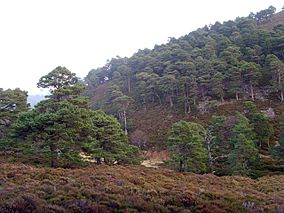Glen Tanar facts for kids
Quick facts for kids Glen Tanar |
|
|---|---|
|
IUCN Category IV (Habitat/Species Management Area)
|
|

Scots pines in Glen Tanar
|
|
| Location | Glen Tanar, Aberdeenshire, Scotland |
| Area | 41.9 km2 (16.2 sq mi) |
| Designation | NatureScot |
| Established | 1979 |
| Owner | Glen Tanar Estate |
Glen Tanar is a beautiful valley, or "glen," located in eastern Scotland, in an area called Aberdeenshire. A river named the Water of Tanar flows through this valley. Near the end of the glen, the Water of Tanar joins the larger River Dee. The River Dee then flows through an area known as Deeside and eventually reaches the North Sea at Aberdeen.
Glen Tanar is very special because it has the third largest area of Caledonian Forest in Scotland. This ancient forest is important not just for Scotland, but for all of Europe!
About 42 square kilometers (which is about 16 square miles) of Glen Tanar is a National Nature Reserve (NNR). This means it's a protected area managed by NatureScot. Most of this land is privately owned by the Glen Tanar Estate. However, a smaller part, about 182 hectares (450 acres), is owned by NatureScot and is a "Strict Reserve Zone."
Glen Tanar is also part of the Cairngorms National Park. It has other special protections too, like being a Site of Special Scientific Interest (SSSI) and a Special Protection Area (SPA). These protections help keep its unique nature safe.
Contents
Exploring Glen Tanar's Trails
Glen Tanar is a popular spot for hikers. It's the starting point for the eastern route to Mount Keen. Mount Keen is the most easterly mountain in Scotland that is tall enough to be called a Munro.
Hikers usually start their journey from a car park at the end of the public road. They follow a path through the native Caledonian Forest. After walking through the trees, the path opens up into wide, open moorland. Hikers then cross the river before starting their climb up Mount Keen.
Amazing Plants and Animals of Glen Tanar
Glen Tanar, along with its smaller side valleys like the Water of Gairney and the Water of Allachy, holds the third largest area of Caledonian Forest in Scotland. This forest grows from the valley floor all the way up to 450 meters (about 1,476 feet) high.
Trees and Plants in the Forest
The main tree you'll see in the Caledonian Forest is the Scots pine. But there are also many other types of trees, like birch, alder, rowan, holly, aspen, and oak. Near the edge of the forest, where it meets the open moorland, you can find juniper bushes.
The forest floor is covered with plants like blaeberry, heather, and soft feather mosses. You might also spot some special woodland flowers such as twinflower, creeping lady's-tresses, and different types of wintergreen.
Insects and Bugs
Glen Tanar is home to many interesting insects that are typical of the Caledonian Forest. Some rare ones include the false blister beetle, a type of hoverfly called Callicera rufa, the bumblebee robberfly, and the beautiful green hairstreak butterfly.
Birds of Glen Tanar
This area is very important for birds, which is why it's a Special Protection Area (SPA). Four bird species are especially important here for breeding:
- Capercaillie (a large woodland grouse)
- Scottish crossbill (a bird found only in Scotland)
- Osprey (a fish-eating bird of prey)
- Golden eagle (a large, powerful bird of prey)
The number of capercaillie living here is very important for the species in Scotland. Sometimes, visitors are asked to avoid certain areas to give these birds space, especially during their breeding season. Glen Tanar is also a great place to see black grouse, hen harrier, golden plover, and merlin. It's probably the most important place in the world for the Scottish crossbill.
Mammals and Fish
You can find several mammals in Glen Tanar, including red squirrels, Scottish wildcats, and otters. The rivers here are also very important for atlantic salmon.
Glen Tanar's Past
Glen Tanar was once part of the lands belonging to the Marquis of Huntly.
Changes by William Cunliffe Brooks
In 1865, a wealthy English lawyer and banker named William Cunliffe Brooks bought the estate. He was also a politician, serving as a MP. Brooks made many big changes to Glen Tanar. He built a large house, homes for his workers, a school, stables, and kennels for dogs. He also built several bridges and designed beautiful gardens.
Brooks also placed many carved stones and memorials around the countryside. Some of these stones playfully mentioned his name, while others praised drinking water instead of alcohol!
The Coats Family Ownership
In 1905, the estate was bought by George Coats. He owned a famous thread manufacturing company called J & P Coats Ltd from Paisley. In 1916, George Coats was given the special title of Baron Glentanar. The estate is still owned by his family today.
Forest Management History
People have been cutting down trees for timber in Glen Tanar for at least 250 years. The first record of a sawmill here dates back to 1732. More trees were cut down during the Victorian era. This, along with more deer and farm animals on the estate, made it hard for the forest to grow back naturally.
Luckily, the forest avoided heavy logging during World War I. In 1937, fences were put up to keep deer out, allowing the forest to regenerate naturally. In the 1950s and 60s, some non-native trees were planted, but these are now being slowly removed.
Seasonal grazing by cattle stopped in the 1990s, and part of the deer fence was removed in 1996. Today, the forest is allowed to grow back on its own. The number of deer is controlled by culling. With less pressure on the forest, trees are now even spreading into the nearby moorland.


